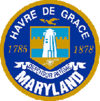Havre de Grace, Maryland facts for kids
Quick facts for kids
Havre de Grace, Maryland
|
||
|---|---|---|
| City of Havre de Grace | ||

Concord Point Lighthouse, the iconic representation of HdG. Sits at the mouth of the Susquehanna River in Havre de Grace
|
||
|
||
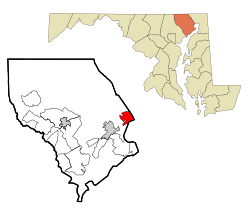
Location in Harford County and in the state of Maryland
|
||
| Country | ||
| State | ||
| County | ||
| Incorporated | 1785 | |
| Area | ||
| • Total | 6.32 sq mi (16.37 km2) | |
| • Land | 5.89 sq mi (15.25 km2) | |
| • Water | 0.43 sq mi (1.12 km2) 20.17% | |
| Elevation | 56 ft (17 m) | |
| Population
(2020)
|
||
| • Total | 14,807 | |
| • Density | 2,514.35/sq mi (970.83/km2) | |
| Time zone | UTC−5 (Eastern) | |
| • Summer (DST) | UTC−4 (Eastern) | |
| ZIP code |
21078
|
|
| Area code(s) | 410 Exchanges: 939,942 | |
| FIPS code | 24-37600 | |
| GNIS feature ID | 0590437 | |
| Website | www.havredegracemd.com | |
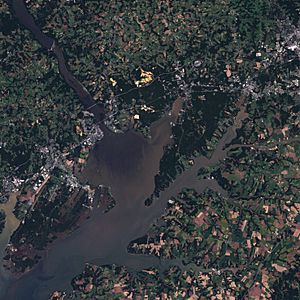
Havre de Grace, abbreviated HdG, is a city in Harford County, Maryland, United States, situated at the mouth of the Susquehanna River and the head of Chesapeake Bay. It is named after the port city of Le Havre, France, which in full was once Le Havre de Grâce (Old French, "Harbor of Grace").
The population was 12,952 at the 2010 United States Census. In 2014, Smithsonian magazine called it one of the 20 best small U.S. towns to visit.
Contents
History
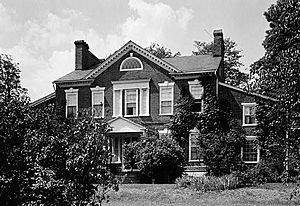
Early history
During the Revolutionary War, the small hamlet known as Harmer's Town was visited several times by General Lafayette, considered a hero of the war. He commented that the area reminded him of the French seaport of Le Havre, which had originally been named Le Havre-de-Grâce. Inspired by Lafayette's comments, the residents incorporated the town as Havre de Grace in 1785.
George Washington stayed overnight in the town in 1789 on the journey to New York City for his first inauguration. During the First Congress in 1789, Havre de Grace missed by only one vote being named the capital of the fledgling United States.
19th century
On May 3, 1813, during the War of 1812, Havre de Grace was attacked by British Rear Admiral George Cockburn who burned and plundered the city. The American Lieutenant John O'Neill single-handedly manned a cannon to help defend the town. He was wounded, captured by the British, and soon released. In gratitude, Havre de Grace made O'Neill and his descendants the hereditary keepers of the Concord Point lighthouse marking the mouth of the Susquehanna River.
The early industry of Havre de Grace included oyster and crab harvesting, and extensive fruit orchards. Products were shipped to markets along the East Coast and upriver.
The town was the southern terminus for the Proprietors of the Susquehanna Canal and later the Susquehanna and Tidewater Canal, which bypassed difficult navigational areas of the lower Susquehanna River between Havre de Grace and Wrightsville, Pennsylvania, where it connected to the Pennsylvania Canal. It was built between 1836 and 1840, but operations on the canal declined after 1855 because of competition from railroads, which could carry freight more quickly. The Lock Keeper's house and remnants of the canal exist today as a museum.
Havre de Grace was a primary town on the Eastern Route of the Underground Railroad in Maryland, as slaves could cross the Susquehanna to havens in the free state of Pennsylvania, traveling on to Philadelphia and New York. Prior to 1840, escaped slaves from communities along the western shore of the Chesapeake Bay came to Havre de Grace and often took the ferry across the Susquehanna River to safe sites in Lancaster and Chester counties in Pennsylvania. When "vigilance increased at the ferry", slaves were guided upriver to cross from Columbia, which had been established by Quakers. The town's different transportation routes enabled slaves to make their way to safe haven in the North.
Havre de Grace became known for duck hunting, and was a seasonal destination for hunters. They stayed at the town hotels and hired local guides to escort them hunting on the river and along the bay. Local artisans became known for their high quality decoy making, which is honored in the Decoy Museum of the city.
By the 1860s, a large population of free African Americans had settled in the town, as its concentration supported independent artisans, as well as jobs associated with shipping on the river and canal and, increasingly, with the railroads. The town was one of seven sites for the recruiting of "U.S. Colored Troops" during the American Civil War. Although in the tidewater area of Harford County, which had large plantations and slaveholders, the city's river and canals tied it to northern industry and trade in Pennsylvania and beyond. These provided urban jobs for free blacks, and the town had a strong proportion of Northern sympathizers among whites as well.
In 1878, the town became a city and established its own government.
Shortly after 1878, Stephen J. Seneca opened a fruit-packing factory in the S. J. Seneca Warehouse with a tin can factory next to Havre de Grace Waterfront. Seneca made improvements to canning with his patents; 1889 Can-soldering machine 1891 Can-soldering machine By 1899, Seneca had become a canned goods broker. Since the original railroad had run down St. Clair Street (now Pennington Ave.) to the river the location of the factory was advantageous for both water and rail shipping. Up until the Second World War many farmers in Harford County brought their produce to the Seneca Factory later run as Stockhams Cannery. S.J. Seneca lived at 200 North Union Ave. was Mayor of Havre de Grace 1893-1894 and donated the Methodist Church.
The Seneca cannery, which is currently in use as an antique shop, is a very good example of a late 19th century brick industrial building. with its severally classical facade and massive stone buttresses on the rear.
20th century
Many patents followed the opening of the S. J. Seneca Cannery. 1901 The Baling-press. 1905 The Cooker 1905 The Tomato-scalder. 1917 Improved Tomato-scalder. 1917 The Can-opener. 1918 The Machine for peeling tomatoes.
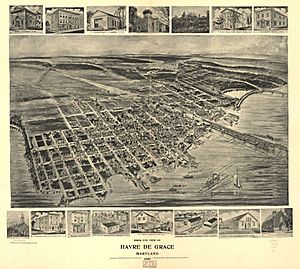
Havre de Grace was known as "The Graw" from 1912 through the 1950s, and it prospered as a stop for travelers. These included gangsters and gamblers en route to New York City from the South following the "pony routes". The Havre de Grace Racetrack operated from 1912 to 1950. Al Capone was reported to have spent some time at the former "Chesapeake Hotel" (now known as "Backfin Blues; Creole de Graw"). At the end of the 1950s, the state removed the horse track, and its race and betting rights were bought by the Pimlico Race Course in Baltimore.
An incident during 1949, when the city denied a license to use a city park and arrested a Jehovah's Witnesses preacher, led to the US Supreme Court case of Niemotko v. Maryland (1951). The court ruled that Jehovah's Witnesses were protected by constitutional rights to the free exercise of religion and the city should have granted them the permit to speak in the park.
A few tenant farmhouses remain from the large Mitchel plantation that overlooked the city. In the 1980s, Havre de Grace began to undergo extensive redevelopment, with renovation of historic properties and adaptation for new uses, as well as construction of new houses and townhouse communities on former farmland. It was becoming a destination for people with second homes for vacations on the bay and retirees. Historic lands and older forests are being cleared, and expensive houses are now extending and growing along Chapel Road northwest towards Webster Village. The city has benefited through development of new properties, antique stories and retail venues since the late 20th century.
21st century

In September 2003, Hurricane Isabel destroyed the promenade and flooded the city about 2 blocks into downtown. In 2004, with very strong efforts from Americorps NCCC, the promenade was reconstructed. It serves as a waterfront boardwalk and nature walk from Tydings Park to the Maritime Museum, and on to Concord Point Lighthouse.
Havre de Grace is a small city, which has recently expanded by annexing land. Housing development is moderate but steady. Per capita income has doubled over the 1990-2000 era, with the arrival of wealthier residents to the newer suburban projects around and in the city. Some commute to jobs elsewhere; others are retirees. New suburban developments since the 1990s have brought thousands of middle-to-upper-class residents to the town. As a result, many working-class citizens who used to live in the city have relocated due to rising land values and changing neighborhoods. Havre de Grace has recently grown related to the BRAC activities of the Department of Defense. DOD recently relocated activities and personnel from various bases to the Aberdeen Proving Ground (APG), a few miles away.
Geography
Havre de Grace is located at 39°32′54″N 76°5′51″W / 39.54833°N 76.09750°W (39.548412, −76.097554) at the mouth of the Susquehanna River.
According to the United States Census Bureau, the city has a total area of 6.89 square miles (17.85 km2), of which 5.50 square miles (14.24 km2) is land and 1.39 square miles (3.60 km2) is water.
Havre de Grace is 40 miles (64 km) northeast of Baltimore, 40 miles (64 km) west of Wilmington, Delaware, 75 miles (121 km) northeast of Washington, DC, and 154 miles (248 km) southwest of New York City.
Climate
The climate in this area is characterized by hot, humid summers and generally mild to cool winters. According to the Köppen Climate Classification system, Havre de Grace has a humid subtropical climate, abbreviated "Cfa" on climate maps.
Demographics
| Historical population | |||
|---|---|---|---|
| Census | Pop. | %± | |
| 1850 | 1,335 | — | |
| 1860 | 1,963 | 47.0% | |
| 1870 | 2,281 | 16.2% | |
| 1880 | 2,816 | 23.5% | |
| 1890 | 3,244 | 15.2% | |
| 1900 | 3,423 | 5.5% | |
| 1910 | 4,212 | 23.0% | |
| 1920 | 4,377 | 3.9% | |
| 1930 | 3,985 | −9.0% | |
| 1940 | 4,967 | 24.6% | |
| 1950 | 7,809 | 57.2% | |
| 1960 | 8,510 | 9.0% | |
| 1970 | 9,791 | 15.1% | |
| 1980 | 8,763 | −10.5% | |
| 1990 | 8,952 | 2.2% | |
| 2000 | 11,331 | 26.6% | |
| 2010 | 12,952 | 14.3% | |
| 2020 | 14,807 | 14.3% | |
| U.S. Decennial Census | |||
2010 census
As of the 2010 United States Census, there were 12,952 people, 5,258 households, and 3,333 families residing in the city. The population density was 2,354.9 inhabitants per square mile (909.2/km2). There were 5,875 housing units at an average density of 1,068.2 per square mile (412.4/km2). The racial makeup of the city was 75.7% White, 16.8% African American, 0.3% Native American, 2.4% Asian, 0.1% Pacific Islander, 1.1% from other races, and 3.7% from two or more races. Hispanic or Latino of any race were 4.7% of the population.
There were 5,258 households, of which 30.3% had children under the age of 18 living with them, 46.6% were married couples living together, 12.7% had a female householder with no husband present, 4.1% had a male householder with no wife present, and 36.6% were non-families. 29.7% of all households were made up of individuals, and 10.3% had someone living alone who was 65 years of age or older. The average household size was 2.42 and the average family size was 3.02.
The median age in the city was 41.9 years. 21.9% of residents were under the age of 18; 7.6% were between the ages of 18 and 24; 25.1% were from 25 to 44; 31.4% were from 45 to 64; and 13.9% were 65 years of age or older. The gender makeup of the city was 48.4% male and 51.6% female.
Economy
Industries in Havre de Grace include leading global technology companies like EFC and Evonik as well as market leaders like Dunlop and Smuckers.
Transportation
Roads and highways
The primary means of travel to and from Havre de Grace is by road. The most prominent highway through the city is U.S. Route 40, which runs east to Wilmington and west to Baltimore. US 40 also includes the Thomas J. Hatem Memorial Bridge, the road bridge that crosses the Susquehanna River directly from the city. Many travelers reach Havre de Grace via Maryland Route 155, which connects to nearby Interstate 95. State highways serving the city include Route 7, Route 490, and Route 763.
Railroads
Two railroad mainlines pass through Havre de Grace. More than 80 daily passenger trains on Amtrak's busy Northeast Corridor speed through the city at 90 miles per hour (145 km/h) on an elevated line connected to the adjacent Amtrak Susquehanna River Bridge. The double-track bridge was built by the Pennsylvania Railroad between 1904 and 1906 for its New York City–Washington, D.C. line. (The bridge replaced a wooden single-track railroad bridge, completed in 1866 by the Philadelphia, Wilmington, and Baltimore Railroad, whose piers can still be seen from the city's David R. Craig Park.) The Philadelphia Subdivision of CSX Transportation, originally built by the Baltimore and Ohio Railroad, carries a heavy volume of freight across the river on the CSX Susquehanna River Bridge, rebuilt between 1907 and 1910, about 1 mile (1.6 km) upstream of the Amtrak bridge.
Attractions
Havre de Grace's location at the head of the Chesapeake Bay and the mouth of the Susquehanna River makes it popular for recreation and tourism. There are marinas and service operators along the shore line. The city yacht basin and park sponsors various events each year. The restored promenade and boardwalk that runs along the shore from the Concord Point Lighthouse to the yacht basin is a favorite place for locals and tourists to walk and enjoy views of the bay.
In 1987, the central business district was added to the National Register of Historic Places as the Havre de Grace Historic District, which recognizes its architecture and historic fabric. A variety of museums help explain and interpret the city's rich maritime past and present: the Decoy Museum, the Havre de Grace Maritime Museum, Concord Point Lighthouse, the Lockhouse Museum, the Black Eyed Susan paddle steamer. Havre de Grace also claims a renovated seaplane port. The city has four public schools and Harford Memorial Hospital, the first to be established in Harford County.
Notable people
- Charles Bradley (born May 16, 1959), NBA player for the Boston Celtics and Seattle SuperSonics 1981–1984
- David R. Craig (born June 12, 1949), Harford County Executive, 2005–2014
- Nella Dodds (born January 25, 1950), singer, actress
- Barry Glassman (born March 24, 1962), Maryland Delegate, 1999–2014; County Executive, 2014- present
- David Hasselhoff (born July 17, 1952), actor and musician
- Brionna Jones (born December 18, 1995), WNBA player
- James Miller (1963-2002), also known as Fan Man, a parachutist and paraglider known for his appearances at various sporting events
- Ultra Naté (born November 2, 1968), house music singer, songwriter, and record producer
- Immanuel Quickley (born June 17, 1999), college basketball player for the University of Kentucky, 2019-2020 SEC Player of the Year, and professional basketball player.
- Bill Ripken (born December 16, 1964), MLB player for the Baltimore Orioles, Texas Rangers, Cleveland Indians and Detroit Tigers; brother of Cal Ripken, Jr.
- Cal Ripken, Jr. (born August 24, 1960), Major League Baseball player and Hall of Famer for the Orioles
- Frederick Rodgers (1842-1917), United States Navy rear admiral
- William Sleator (1945-2011), author of young adult science-fiction novels including House of Stairs and Interstellar Pig
- Millard Tydings (1890-1961), U.S. Senator 1927–1951
- Kim Waters (born March 18, 1965), musician
- Tobias Watkins (1780-1855), physician, editor, and write
Local media
- The Record, St. John Street, Havre de Grace
- The Aegis, Bel Air
- The Sun, Baltimore
- WHGM - A classic hits radio station based in Havre de Grace
- WXCY - A country music radio station based in Havre de Grace
Havre de Grace is primarily served by Baltimore TV stations, but some residents also receive Philadelphia stations.
Twinning
Havre de Grace is twinned with Mumbles, ![]() Wales
Wales
In popular culture
A season four episode of the television show Boardwalk Empire was named for the city and partially took place there.
The city stood in for Gaffney, South Carolina, Kevin Spacey's character Frank Underwood's hometown in House of Cards.
In July 2007, the movie From Within (2008) was filmed in Havre de Grace.
In 2018, Maryland-based stand-up comedian Tom Myers recorded his CD "Make America Innate Again" in the Black Box at the Cultural Arts Center. Additionally the opening track is titled "Hello, Havre De Grace."
| Wikisource has the text of the 1879 American Cyclopædia article Havre de Grace. |
 |
Darlington |
Port Deposit |
Perryville |
 |
| Churchville |
Susquehanna River | |||
| Aberdeen |
Chesapeake Bay | Chesapeake Bay |
See also
 In Spanish: Havre de Grace (Maryland) para niños
In Spanish: Havre de Grace (Maryland) para niños


